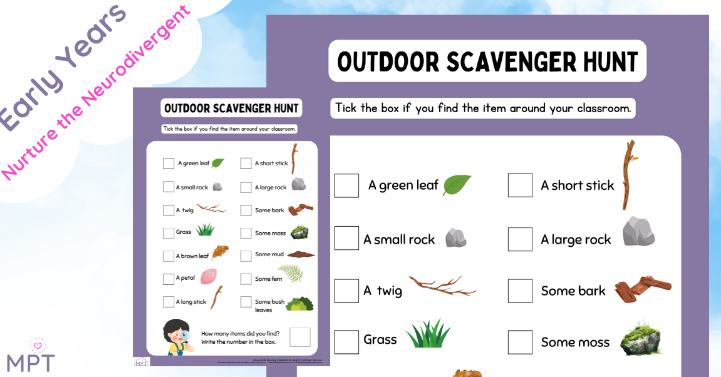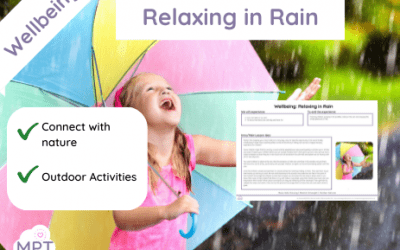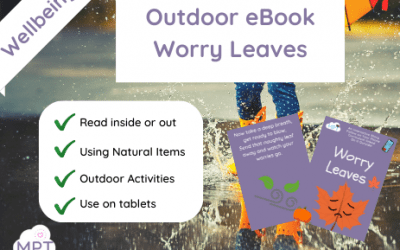Wellbeing: Leaf Love ⇒Use the Leaf Love to help children have a method to help them connect with nature. Connecting to...
Relaxing in the Rain (Wellbeing)
Sep 8, 2021
Wellbeing: Relaxing in the Rain ⇒Use the Relaxing in the Rain lesson plan to make the most of outdoor learning. Do...
Mindful Mud (Wellbeing)
Sep 8, 2021
Wellbeing: Mindful Mud ⇒Use the Mindful Mud method and let mud and mess make you all feed good! ⇒Single Lesson Plan We...
Worry Leaves (Outdoor eBook)
Sep 7, 2021
Worry Leaves ⇒This eBook can be read outdoors in indoors, with tasks to do outdoors after ⇒Single Text We will...
Wellbeing: Puddle Pondering
Sep 2, 2021
Puddle Pondering is a fabulous way to get your sillies out. Being silly is extremely important for children to be...
Wellbeing : Clearing Cloudy Minds
Sep 2, 2021
Clearing cloudy minds and being mindful is imperative in all of our lives. We lead busy, fast-paced lives and...
Super Positive Power Leaves
Sep 1, 2021
Super Positive Power Leaves Play 'Super Positive Power Leaves' and end your lesson on a high. ?Ask the children to...
Well-being: Worry Leaves
Sep 1, 2021
Worry Leaves This lesson plan will cover the following objectives: A chance to talk and be open with our feelings. To...
Well-being: Mood Leaves
Sep 1, 2021
Mood Leaves Use this natural and nurturing lesson plan and let nature help the children to connect with their...
Institute for Outdoor Learning – Horizons – Summer Edition
Jul 28, 2021
Ten activities all Muddy Kids Should be doing over the Summer This article can be found in the Horizon Magazine...
Bug Spotter Template
Jun 9, 2021
Use this bug spotter sheet to get your class outside muddya nd messy! Supports the new EYFS curriculum.
S1E3: Let’s chat about the 7 Strands with June O’Sullivan MBE
Apr 29, 2021
An inspiring speaker, author and regular media commentator on Early Years, Social Business and Child Poverty, June...
Farm Park Resource (Footprint Spotter Sheet)
Apr 25, 2021
Going on a Farm Park Trip? Use Farm Park Resource (Footprint Spotter Sheet) to get your class outside, in the mud and...
Muddy Phonics Phase One Planning Unit
Apr 22, 2021
Muddy Phonics Phase One Planning (Scheme of work) will help you make that muddy step to take more of your phonics...
Early Years Planting Calendar
Apr 19, 2021
Use the Early Years PLanting calendar to get a fun and organised planner to help you plant various plants if you are...
Teddy Bears Picnic Ideas pack (Tots)
Apr 12, 2021
Use Teddy Bears Picnic Ideas pack for Tots to get this much-loved song and story outside the Muddy Puddles Way! EYFS...
Sunflower Day Growth Chart – EYFS/KS1
Apr 11, 2021
EYFS/KS1 - Enjoy using this resource on Sunflower Day so that the children can record the height and observe their...
*FREE* Signs of Summer Explorer Sheet
Jan 27, 2021
Use the Signs of Summer Explorer Sheet to get the children outside applying their Science and wonder of the world the...
New In

Outdoor Learning Scavenger Hunt (Toddlers)

Outdoor Learning Scavenger Hunt

Bug Outdoor Learning Scavenger Sheet

Outdoor Learning Activities for Nursery – Resource Pack

Outdoor Learning Safety Poster

Outdoor Learning Risk Assessments: (Handout)

Outdoor Learning Safety Advice (CPD Handout)

Outdoor Learning CPD Guidance (Handout )

Outdoor Learning Ideas for Schools: Engaging Ways to Teach Outside




















